D: All right, Yaël, you're a moth. And mating for you is a big deal because it takes eight or nine hours. So the last thing you want is for some predator to interrupt you and your mate in the act.
Y: I'm guessing that's true not just for moths. It's just that moths can't put up a do-not-disturb-sign.
D: Well, in some sense, they can. You see, certain species of male moths use toxins to protect themselves during sex. In fact, during the courtship dance, the male moth releases a derivative of these toxins, which enables the female to choose the moth who can offer her the most protection.
Y: Are the males just born with these toxins?
D: Actually, the toxins come from plants. The male rattlebox moth gets these toxins in its larval stage, when it eats from the rattlebox plant. The wasp moth, on the other hand, gets them from the poisonous dogfennel plant before the big night. In both cases, the chemicals make the moths so unappealing that spiders have actually been observed cutting them loose from their webs.
Y: That's one handy toxin.
D: When the moths mate, the male passes the toxins along with his sperm to the female, and the wasp moth actually releases the toxin in a cloud of miniature confetti that sticks to him and the female. The toxin protects them both during mating, and continues to protect the female and the eggs later on. In fact, the rattlebox moth passes enough toxins to the female that she's protected from predators for the rest of her life span, which is about thirty days.
Y: All this makes me wonder what my husband has done for me lately.









